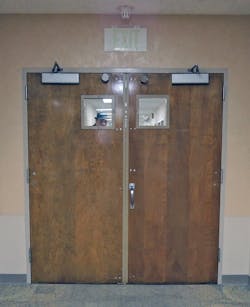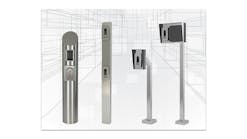A fire rated opening is part of a building's passive fire protection system that provides two distinct functions: reduce the spread of fire and/or smoke and enable safe egress from the building in the event of a fire.
For an opening to qualify as fire rated, the door, jamb, hardware* and any required gasketing must be listed with a agency with laboratory that is in compliance with NFPA Standards 80 and 101, building codes and any ordinances.
*There are two exceptions for a fire rated opening. Kick plates below 16 inches tall do not require labeling, and until recently, fire rated hinges did not have to have a visible label.
Fire rated components include hinges, lock/exit device, door closer, astragal, door coordinators, power transfer devices, glass lites and door viewers. In addition, any add-on components including door and jamb protection must be listed if they are to be mounted onto or into the surface of the door or jamb.
NFPA 80 4.2 Listed and Labeled Products.
4.2.1 Listed items shall be identified by a label.
Every Listed component on a fire rated opening must have a marking from the listing/labeling agency. The marking must be in the form of a label, stamping on the product or any other marking means permitted by the agency. Examples of testing agencies are Underwriters' Laboratory and Warnock Hersey.
NFPA 80, Annex A.
A.4.2.1 Labels can be permitted to be of metal, paper, or plastics and can be permitted to be stamped or die cast into the item. Labels should not be removed, defaced, or made illegible while the door is in service. If the label on an existing fire door has been removed or is no longer legible, it is acceptable to verify the rating of the fire door through other means acceptable to the authority having jurisdiction such as an inspection or certification service that provides acceptable documentation.
NFPA 80 4.2 Listed and Labeled Products.
4.2.2 Labels shall be applied in locations that are readily visible and convenient for identification by the AHJ after installation and assembly.
The door label is normally installed onto the hinge edge of the door above the middle hinge. The jamb label is normally positioned at the same height where the door edge would cover it or along the header. Some labels may be located out of sight to be hidden from casual observers.
According to 4.2.2, fire rated components’ labels, stamping or castings are supposed to be readily visible and convenient for identification. This is a bit of an exaggeration as some fire rated doors have labels on the top, making it more difficult to see.
Depending upon the year and the door manufacturing company, labeling can be a metal plate that is nailed or riveted in place.
In addition to identifying the products as fire rated, fire rated door and jamb labels list the duration of the fire rating and can provide the minimum latch throw, gasketing requirement, positive pressure and the type of hardware that must be installed onto the door. Most doors are constructed for installation singly or in pairs.
For example, if the fire door is equipped with fire exit hardware, additional requirements from NFPA 101, IBC 2012, and IFC 2012 cover building codes and local ordinances. All of these guide codes requires the device to open in the direction of exit travel. The length of the activating portion of the device must be at least half the width of the door leaf. Plus, the device cannot be installed at less than 30" nor more than 44" above the finished floor. To release the door latch, a force not to exceed 15 pounds is applied.
Chapter 4 General Requirements
4.1.1 Classification. Fire doors and fire windows shall be classified by designating a required fire protection rating expressed in hours or fractions thereof.
Fire rated doors and jambs have their own fire rating duration. Fire rated openings have fire rating durations expressed in minutes or in hours. Fire rated doors and jambs can have a duration time from a minimum of 20 minutes (1/3 hour) to a maximum of three hours (180 minutes).
The minimum latch throw is ½" or ¾" depending upon the door.
To determine the duration of a fire rated opening, the fire rating for each component must be determined. The component with the shortest duration determines the fire rating duration of the entire opening.
For a theoretical opening, the door and frame are rated at three hours; the lock and door closer are rated for three hours. The exit device is rated for 90 minute. The exit device, having the shortest rated duration, makes the overall fire rating duration of the assembly 90 minutes.
4.1.3.3 Surface applied hardware shall be applied to the door or frame without removing material other than drilling round holes to accommodate cylinders, spindles, similar operational elements, and through bolts in doors.
4.1.3.4 The holes described in 4.1.3.3 shall not be permitted to exceed a diameter of 1 in. (25.4 mm) with the exception of cylinders.
When installing mop plates, kick plates, armor plate or other forms of labeled door or jamb protection, the plates can only be mounted using double stick tape or magnetic backing (metal doors). If the door manufacturer has prepped the door for the plate, the plate must be installed according to the door manufacturers written instructions.
For fire rated openings, the door and jamb do not have to have the same testing laboratory label, as long as the door and frame were tested to the same standard. Another reason there are different labels could be because the door may have had to be replaced or required field inspection as a result of modification or a destroyed label.
Fire Door Basic No-Nos
A fire rated opening requires that the door, hardware and labels are attached and in good condition. The label cannot be painted over. There cannot be any damage to the door face or edges including sanding the edge of a wood door. If the door is equipped with a metal label, it cannot appear as if the label had been removed and re-attached.
If a wood (laminate) door has damage that does not include a hole, it may be a good idea to take a photo and send it to the door manufacturer to have them determine if the door still meets the testing laboratory's requirements. The door hardware must be intact with the label visible.
If a fire rated door is equipped with a plate taller than 16 inches, the plate must have a Listing and be labeled. The Listing is usually stamped into the plate.
Locking hardware must be complete and firmly installed onto the door. There cannot be any missing parts. For example, if an exit device is missing the filler plate or is improperly cut, leaving a gap of 1/8" or greater, the exit device fails. The solution is to install a properly cut piece of filler plate.
If door hardware is through bolted on, a wooden door and the bolts have become recessed into the face of the door, the through bolts must be removed and re-installed with either steel washers or a mounting plate that is at least twice the diameter of the bolt head.
A fire rated door closer cannot be equipped with a hold-open arm.
A fire rated exit device cannot be equipped with mechanical dogging.
When a fire rated door is equipped with a surface mounted vertical rod exit device, the door has been factory prepped. If the door has been factory prepped for Less Bottom Rod (LBR) as part of a double-door application, there will be at least one thermal pin that is pointed at a receiver in the inactive door.
Note: Removing the lower rod and latch from a single door cancels out the fire rating.
Fire Door Clearance
NFPA 80 has dimensional requirements for the gap size between the fire rated door and the jamb, the non-combustible, surface (floor) and the non-combustible, threshold.
The fire door clearance at the door edge to the jamb on the pull side of the door must not exceed 1/8” for wood or metal doors. For no threshold surfaces, the undercut is ¾”. For openings equipped with a raised threshold, the undercut is 3/8 “.
Visit www.doorgapgauge.com to learn about special tools used to assess and measure fire rated doors.






